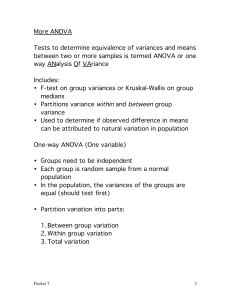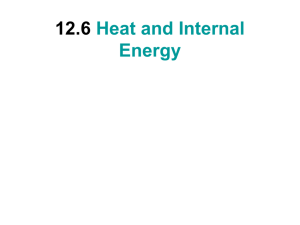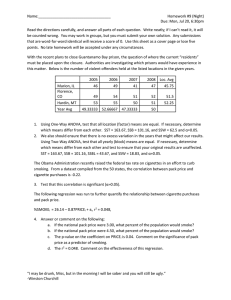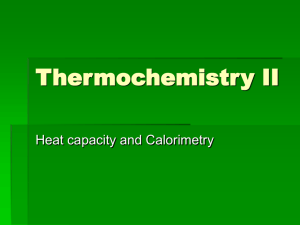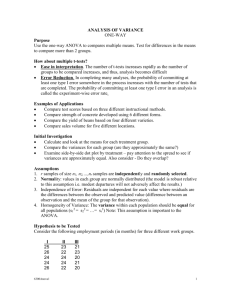IEOR 165 Homework 2 Due March 5, 2015
advertisement
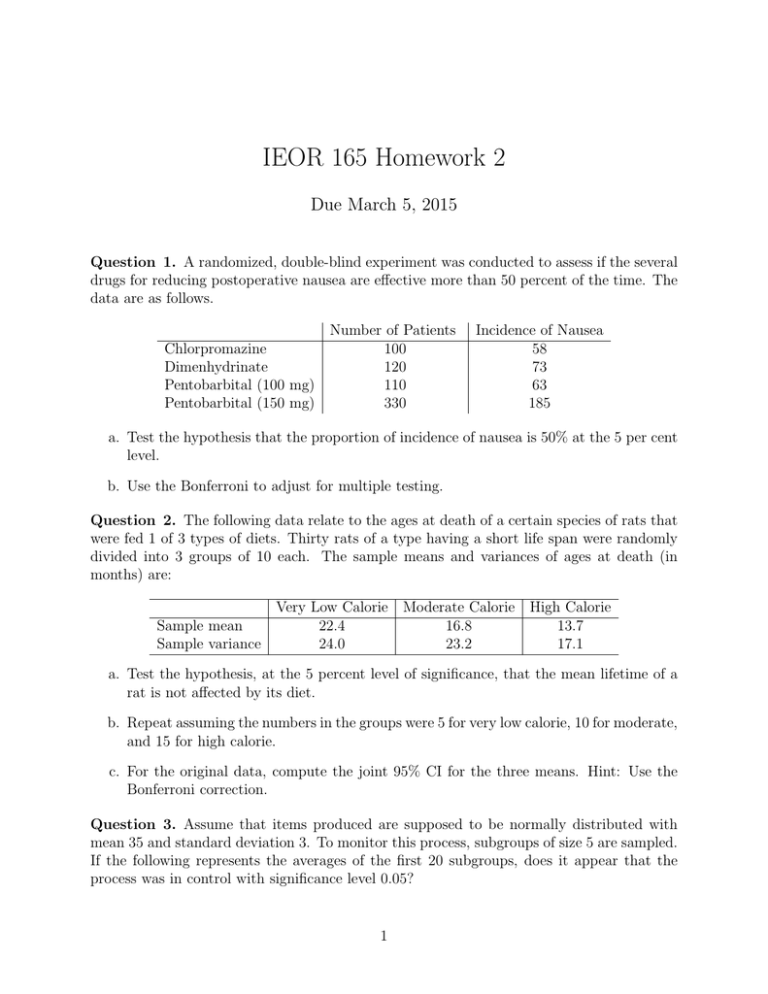
IEOR 165 Homework 2 Due March 5, 2015 Question 1. A randomized, double-blind experiment was conducted to assess if the several drugs for reducing postoperative nausea are effective more than 50 percent of the time. The data are as follows. Chlorpromazine Dimenhydrinate Pentobarbital (100 mg) Pentobarbital (150 mg) Number of Patients 100 120 110 330 Incidence of Nausea 58 73 63 185 a. Test the hypothesis that the proportion of incidence of nausea is 50% at the 5 per cent level. b. Use the Bonferroni to adjust for multiple testing. Question 2. The following data relate to the ages at death of a certain species of rats that were fed 1 of 3 types of diets. Thirty rats of a type having a short life span were randomly divided into 3 groups of 10 each. The sample means and variances of ages at death (in months) are: Sample mean Sample variance Very Low Calorie 22.4 24.0 Moderate Calorie 16.8 23.2 High Calorie 13.7 17.1 a. Test the hypothesis, at the 5 percent level of significance, that the mean lifetime of a rat is not affected by its diet. b. Repeat assuming the numbers in the groups were 5 for very low calorie, 10 for moderate, and 15 for high calorie. c. For the original data, compute the joint 95% CI for the three means. Hint: Use the Bonferroni correction. Question 3. Assume that items produced are supposed to be normally distributed with mean 35 and standard deviation 3. To monitor this process, subgroups of size 5 are sampled. If the following represents the averages of the first 20 subgroups, does it appear that the process was in control with significance level 0.05? 1 Subgroup No. 1 2 3 4 5 6 7 8 9 10 X̄ 34.0 31.6 30.8 33.0 35.0 32.2 33.0 32.6 33.8 35.8 Subgroup No. 11 12 13 14 15 16 17 18 19 20 X̄ 35.8 35.8 34.0 35.0 33.8 31.6 33.0 33.2 31.8 35.6 Question 4. Suppose we would like to use an exponentially weighted moving-average control chart for data that should come from N (µ = 5, σ 2 = 2). Assume the subgroup size is n = 10, and that we have chosen γ = 0.2. Use a Monte Carlo algorithm to determine the value of so that the expected number of subgroups that are analyzed before the process is determined to be out of control (in the case where the process never goes out of control) is 1000. Return your results and code. 2 Solution 1. a. Under H0 , ∑ Xi ∼ Bin(100, 0.5). ∑ Xi ≥ 59 | p = 0.5) p − value = P ( = 0.0443 Retain H0 . (1-binocdf(58, 100, 0.5)) ∑ Under H0 , Xi ∼ Bin(120, 0.5). ∑ p − value = P ( Xi ≥ 74 | p = 0.5) = 0.0067 Retain H0 . (1-binocdf(73, 120, 0.5)) ∑ Under H0 , Xi ∼ Bin(110, 0.5). ∑ p − value = P ( Xi ≥ 64 | p = 0.5) = 0.0523 Retain H0 . (1-binocdf(63, 110, 0.5)) ∑ Under H0 , Xi ∼ Bin(330, 0.5). ∑ p − value = P ( Xi ≥ 186 | p = 0.5) = 0.0119 The test results is strong enough to reject H0 at the 5 percent level of significance. (1-binocdf(185, 330, 0.5)) b. (p1 , p2 , p3 , p4 ) = (0.04443, 0.0067, 0.0523, 0.0119) Reject hypothesis only when pi < α/k = 0.05/4 = 0.0125 Reject H2 and H4 . Solution 2. Assume normal data, with equal but unknown variance σ 2 . a. m = 3, n = 10. H0 : µ1 = µ2 = µ3 , H1 : some difference. 3 Since Si2 = 1 n−1 ∑n j=1 (Xij − X i )2 , for i = 1, 2, 3. It follows SSW = m ∑ n ∑ (Xij − X i )2 i=1 j=1 = m ∑ (n − 1)Si2 i=1 = (n − 1) m ∑ Si2 i=1 = (10 − 1)(24.0 + 23.2 + 17.1) = 578.7 Also, X = 1 m ∑m i=1 X i = 13 (22.4 + 16.8 + 13.7) = 17.63. Then we have SSb = n · m ∑ (X i − X)2 i=1 = 10 · [(22.4 − 17.63)2 + (16.8 − 17.63)2 + (13.7 − 17.63)2 ] = 388.9 TS = SSb /(m − 1) 388.9/(3 − 1) = = 9.072 SSW /(nT − m) 578.7/(30 − 3) p − value = P (Fm−1,nT −m > T S) = P (F2,27 > 9.072) = 0.00097 < 0.05 So we reject H0 . we are 95% confident that there is a statistically significant difference between mu1 and mu2 and between mu1 and mu3. b. m = 3, n1 = 5, n2 = 10, n3 = 15. H0 : µ1 = µ2 = µ∑ 3 , H1 : some difference. ni 1 2 Since Si = ni −1 j=1 (Xij − X i )2 , for i = 1, 2, 3. It follows SSW = = ni m ∑ ∑ (Xij − X i )2 i=1 j=1 m ∑ (ni − 1)Si2 i=1 = (5 − 1)24.0 + (10 − 1)23.2 + (15 − 1)17.1 = 544.2 1 X = (5(22.4) + 10(16.8) + 15(13.7)) = 16.2 30 SSb = m ∑ ni (X i − X)2 i=1 = 5(22.4 − 16.2)2 + 10(16.8 − 16.2)2 + 15(13.7 − 16.2)2 = 289.54 4 SSb /(m − 1) 289.54/(3 − 1) = = 7.18 SSW /(nT − m) 544.2/(30 − 3) p − value = P (Fm−1,nT −m > T S) = P (F2,27 > 7.18) = 0.0032 < 0.05 TS = So we reject H0 . c. Xi ± zα/3 si √ ni for all i Solution 3. When in control, X ∼ N (35, 9). n = 5. √ √ LCL = µ − σ · z(1−α/2) / n = 35 − 3 · 1.96/ 5 = 32.37 √ √ U CL = µ + σ · z(1−α/2) / n = 35 + 3 · 1.96/ 5 = 37.63 X̄ < LCL, so the process is out of control since the 2nd, 3rd, 6th, 16th, 19th subgroup. Solution 4. function MCsim() alpha=0.001:0.0005:0.005; L = zeros(1,length(alpha)); n=10; gamma = 0.2; npath = 10000; maxIter = 2000; M = zeros(1,npath); numSubGrp = zeros(1,npath); mu = 5; sigma = sqrt(2); for k=1:length(alpha) disp(k); LCL(k)=mu-sigma*norminv(1-alpha(k)/2)/sqrt(n*(2-gamma)/gamma); UCL(k)=mu+sigma*norminv(1-alpha(k)/2)/sqrt(n*(2-gamma)/gamma); M(1) = mean(normrnd(mu,sigma,[1 n])); for ind=1:npath j=0; while(M(j+1)<=UCL(k) && M(j+1)>=LCL(k) && j<=maxIter) j=j+1; M(j+1)=gamma*mean(normrnd(mu,sigma,[1 n]))+(1-gamma)*M(j); end numSubGrp(ind) = j; end L(k) = mean(numSubGrp); end out = [alpha’, L’]; end 5
